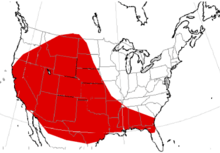Temnocyon
| Temnocyon Temporal range: Oligocene–Early Miocene | |
|---|---|
| Scientific classification | |
| Kingdom: | Animalia |
| Phylum: | Chordata |
| Class: | Mammalia |
| Order: | Carnivora |
| Superfamily: | Arctoidea |
| Family: | Amphicyonidae |
| Subfamily: | Temnocyoninae |
| Genus: | Temnocyon |
| Species | |
| |
 | |
| Range of Temnocyonines based on fossil record | |
Temnocyon is an extinct genus of carnivorous mammals belonging to the family of Amphicyonidae (Bear-dog) endemic to North America that lived during the Oligocene to Early Miocene approximately 30.3—20.6 mya existing approximately 9.7 million years.[1]
Taxonomy
Temnocyon was named by Cope (1879). Its type is Temnocyon altigenis. It was assigned to Amphicyonidae by Cope (1879) and Carroll (1988); and to Temnocyoninae by Hunt (1998).[2]
Morphology
A single specimen was examined for by body mass by Legendre and Roth. It was estimated to have weighed 21.3 kg (47 lb).[3]
Fossil distribution
The first fossils are recorded in North America at Logan Butte in the John Day beds of Oregon 29–29.5 Ma., in the Sharps Formation of the Wounded Knee area, South Dakota 28–29.5 Ma, and in the Gering Formation at Wildcat Ridge, Nebraska 28.3 Ma. These early temnocyonines attained the size of coyotes or small wolves (15–30 kg) are identified by a uniquely specialized dentition. The last documented occurrences of temnocyonines are found in sediments in northwest Nebraska and southeastern Wyoming (Hunt, 2004).[4]
References
- ↑ PaleoBiology Database: Temnocyon, basic info
- ↑ R. M. Hunt. 1998. Amphicyonidae. 196-227
- ↑ S. Legendre and C. Roth. 1988. Correlation of carnassial tooth size and body weight in recent carnivores (Mammalia). Historical Biology 1(1):85-98
- ↑ Hunt, Robert M, Jr. (2004) "Global Climate and the Evolution of Large Mammalian Carnivores during the Later Cenozoic in North America" in Cenozoic Carnivores and Global Climate by Robert M. Hunt, Jr.